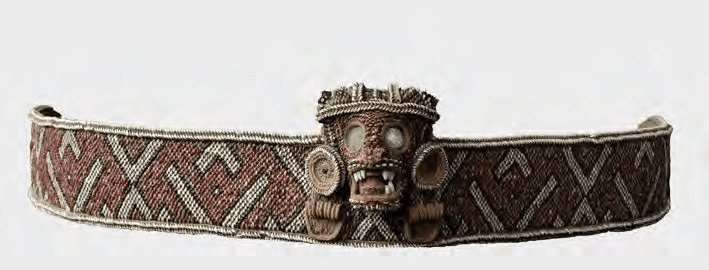The following are words from the indigenous Taino language of the Greater Antilles. Largely derived from Las Casas and Oviedo, chroniclers who spent a significant time in the Caribbean during the 1500s, they both included several words from the Taino tongue in their works. Unsurprisingly, toponyms, flora and fauna, and sometimes names of caciques frequently appeared in their works. The words used below also include some from Puerto Rico's rivers and place names, as well as Abbad y Lasierra. But the vast majority are derived from Oviedo and Las Casas, particularly the latter's Historia Apologética.
Amaguey (valley and river)
Hami (river)
Zapita (river)
xoxenes (mosquitoes)
Bahabonico (river)
xaguey (cisterns?)
guayagas (roots grown and used to make a type of bread)
batata
bejucos (vines/cords)
Haina (rio)
Iguamuco (provincia)
Banique
Hatiey (another province)
Atibonico (Artibonite River)
Zahay (provincia), puerto de golfo de Xaragua
Guacayarima (anus of island)
Camin (rio)
Careibana (area on a plain)
Cayguani
ciba (stone)
streams in Cibao area: Xagua, Guaba, Guanahoma, Baho, Yaqui, Xanique, Agmina, Maho, Paramaho, Guavobin
guabina (type of fish)
dahos, zages, diahacas (types of fish consumed)
teti (fish caught in streams)
xaibas (crabs)
hicotea (turtle)
Buenicun (stream in Cibao area)
Coactinucum (another stream)
Cibu (another stream)
Maimon and Yuma: river names
Dahahon (river name)
Magua (Vega)
higuacas (large parrots)
xaxabis (medium-sized parrots)
quemi (one of the rodents of Hispaniola)
mohies (other type of rat)
curies (other type of rodent consumed)
iguana
aji
manati
yuca, yucabia (plant)
aje
lerenes and yahubias (other types of roots)
guayaros: root in the monte
guariqueten
cibucam (type of manga)
hibiz (sifter)
libuza (cuero used to grate finer yuca)
hien: poisonous juice from yuca
annona (type of fruit)
pitahaya, guanabana
tuna (type of fruit)
hicacos (type of fruit)
ceiba tree
caoban tree: good wood used for tables
caimito: type of tree
guazimas: type of tree
hibuero tree
cupey tree
guao tree (in eastern Hispaniola; used to make poison for arrows according to Las Casas)
manibari (type of yerba)
van (type of yerba)
xeyticaco
buticaco
mahite
taguaguas (earrings)
matunheri
cabuya
hupia
hutia
carey
dita
cohoba
canoa
cazabi
areito
batey
hequeti (uno)
yamoca (dos)
canocum (tres)
yamoncobre (cuatro)
cemi
Lucayo
manicato
caribes
Cibago
Higuey
Saona
Jamaica
Borinquen
Quisqueya
maraca
xaoxao
Yaquimo
Hanyguayaba
jagua
Cacibajagua
bixa
macana
Ciguayo
nitaino
naboria
cocuyo
bahari
Guamiquina
daca
cayo
Zuania
Agueybana
Cayacoa
coa
cimarron
hamaca
conuco
tabaco
Haiti
Cuba
buren
eracra
guayacan
guayaba
Guaba
mamey
Coaybay
behique
bohio
caney
yuca
yucayeque
barbacoa
nahe
cacona
caona
nagua
guanin
maiz
mani
Xaragua
Magua
Maguana
mohuy (animal)
cigua (tree)
damahagua tree (used for cords)
daguita (string)
azuba tree
yayama (pineapple)
yayagua
papaya
boniama
cauallos
hobos tree
higuero tree
guama tree
macagua tree
guiabara tree
gaguey tree
sibucan (tree)
guao: root that's poisonous and used by Indian women of Hispaniola to whiten their skill
guazabara (skirmish, conflict, fight)
guatiao (brother, friend)
datihao (my master, or one named like me (Oviedo)
tabonuco (type of glue from a tree), also called tabunuco
guabiniquinax (type of hutia on Cuba)
ayre (another animal in Cuba)
goeiza
sablao (finer type of cazabi/casabe)
anaiboa (flower of yucca plant)
ana (flower)
imocona (type of food)
Loquillo: indio alzado and cacique
Bayamon rio: area described as center for conuco agriculture in 1580s
Toa (rio in Puerto Rico)
Guayanes River (once heavily populated area in time of indios in PR)
Abacoa (river, Arecibo, in Puerto Rico)
Guataca (river in PR)
Camuy (river in PR)
Guaurabo (river in PR)
Guanajibo/Guaynabo (river in PR)
Guayanilla (rio in PR)
Taiaboa (rio in PR)
Jacagua (rio in PR)
Cuamo (rio in PR): River had fountain/source with area featuring healing bath used by INdians, since stone with figures made by Indians found on it)
Guayama (river in PR)
Abey (rio in PR)
Maunabo (rio in PR)
Humacao (rio in PR)
Dagua/Daguao (rio in PR)
Maga (tree used to make tables, seats, etc.)
capa (tree used to make boats, etc)
ucar (tree)
anon (tree)
quibey (yerba with poisonous features)
Inabon (rio in PR)
dautia/autia (jutia in PR)
Guamani (puerto in PR)
Bieque/Vieque (island)
Yabucoa
Isla de Yautias
yaguas (used for houses)
buhios (bohios, spelling of Abbad y la Sierra)
cayuco (small canoe for rivers and short voyages, Abbad y La Sierra)
duho (stool, banco, silla)
athebeane nequen
hicos: cords of a hamaca (Oviedo)
bagua (mar, ocean, sea)
guaraguaos (type of bird)
comejen/comixen
haquetas (smaller shark or fish)




